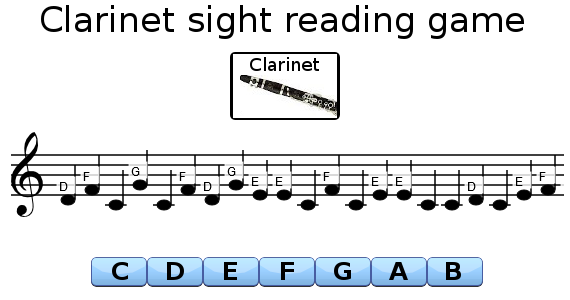There is a great deal of software and online games available to teach music theory and improve sight-reading. Many of these are kid-friendly and can be played on tablets, phones or computers.
Name that Note is a free web-based program with online flash cards for the treble, bass and alto clefs. It also has an option to create personalized levels.
Note Fish
The website is designed to teach students how to read music notes in a fun way. Students can practice with treble, bass and alto clefs. There are also options to learn to read chords. It is not a very robust sight-reading trainer and does not include ledger lines or accidentals, but it can certainly be useful to help students develop their musical vocabulary.
This is a great game to play with your students after you’ve taught them the names of the note symbols on the staff and you want to test their knowledge. The game is very easy to play and there are several levels of difficulty. Students simply click on the fish they think matches the music note they hear. If they are right, they get a point; if they are wrong, they lose a life. After three lives, the game is over. The game is visually stimulating and fun to play, so students will be eager to keep playing to see if they can beat their score.
This is a fun, free music note reading game that can be played as an alternative to the classic card game Go Fish. Students can play individually or in groups. The first player to get a pair of cards in front of them wins the game. You can also use the game to help keep your students connected during summer break. Sending studio families a fun, educational summer note reading game can be an effective tool to retain students and encourage them to continue piano lessons during the summer. You can find lots of other summer piano lesson ideas and resources on Teachers Pay Teachers. This is a trusted marketplace for millions of original educational resources. The site features lesson plans, interactive notebooks, unit studies, interactive games and quizzes, worksheets, printables and more.
Name That Note
Name That Note is a great game for students learning to recognize notes on the staff. This interactive online tool allows you to set up groups of players and play in multiple modes. The variety keeps the games fun, encourages friendly competition and helps students retain the information. This is a great resource for sub days, station or centers and a great way to practice treble clef note names.
There are a few different levels of difficulty on this site but even the beginner level is fun and engaging. The game works in a similar way to Name That Letter, except students answer the question by clicking on a button (responses are displayed as musical sprites).
For the more advanced player, the ninja themed Ningenius is another fun way for players to test their knowledge of note reading. The app offers a Study mode which helps players learn the notes before taking a Test, and players progress through levels by earning karate belts. The app has a range of customization options such as choosing specific individual notes or a range of notes to be tested, a choice of note naming modes and an on-screen keyboard.
The Ningenius app also has a feature which lets teachers create custom games or levels and track student scores. This feature is a great way for teachers to create engaging activities that challenge students without the need for an internet connection.
Another fun game to try is Staff Wars which uses a Star Wars theme to encourage students to learn their note names on the treble and bass clefs. It is a bit more challenging than the above site because it requires you to choose notes by both their names and where they are located on the piano keyboard (a very valuable skill for pianists). This website also has a version which will work offline, but it no longer has a Flash player so it may not function well in older browsers.
Musical Notes
Musical notes are a means of turning an aural art form into something that can be written and shared. A musical note is a single tone of a specified pitch that can be played for a given length of time. The pitch of a note is determined by the vibration of the source, which could be anything from a string (piano or guitar) to a reed (clarinet or saxophone) to lips against metal (trumpet or trombone).
Musical notation has developed over the years to include a set of symbols that represent pitches. In modern music, the pitches are drawn on a staff that has 5 parallel horizontal lines. The staff is divided into parts called clefs, with the most common being treble clef and bass clef. Each clef is assigned a name, and the letters of these names are used to identify the notes that can be found on the staff.
To read music, students need to learn the names of the notes and where they are located on the staff. A number of websites offer free, interactive games to help with this process. A few of these are highlighted below.
Note Rush is a game that lets players hear the pitches and see where they are on the piano keyboard. Users can customize the game by selecting the treble or bass clefs and opting to include ledger lines for a bit of a challenge.
Another good website is musicards, which offers a variety of free online musical flashcards. Users can select between treble, bass and alto clefs and also choose the note values they want to practice. They can even choose to play the notes in a chord to reinforce their learning!
In addition to identifying the note names, students need to understand their relationship to one another. Each note is worth a certain number of beats depending on whether it is a whole, half or quarter. The stems of the notes can point upwards or downwards, and they are also sometimes drawn as a pyramid or tree. When a stem points upwards, it comes out of the right side of the note head; when it is drawn as a pyramid or tree, it goes out from the left.



